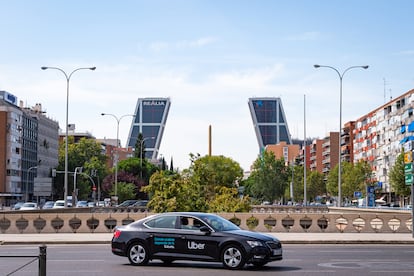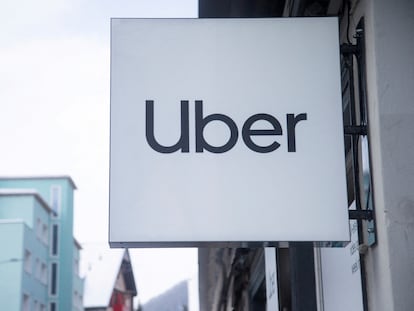Uber’s journey to profitability has reached its destination
After years of losses and regulatory battles, the company founded in 2009 has become a very profitable giant with ambitions to bring all the taxis in the world onto their platform


Uber shareholders have often experienced the same feeling of uncertainty as the users of the service when they see the driver stray from the route. After 15 years and tens of billions in losses, the journey to profitability is finally over. The company, founded in 2009 by Travis Kalanick and Garrett Camp, is not only a global giant, but also a money-making machine. On top of that, Uber has a full tank to continue at full speed for the next few years.
“In Uber’s early days, we were rapidly expanding all around the world while making massive investments to build our category position. Given those enormous losses, many people questioned whether Uber could ever make money,” CEO Dara Khosrowshahi explained this week in a conference call with investors. “[Today] Uber is stronger than ever, delivering exceptional growth and profitability.”
Between 2014 and 2022, Uber accumulated $31.67 billion in losses. The red was the only constant, except for the mirage of an annual profit of $997 million in 2018 due to extraordinary capital gains. The profits of 2023, however, are real. The company achieved a favorable operating result for the first time, which allowed it to close the year with a net result of $1.89 billion, after increasing revenues by 17%, to $37.28 billion. The money that Uber moves is much higher: gross bookings grew by 19%, up to $137.86 billion. “2023 was an inflection point for Uber, proving that we can continue driving profitable growth at scale,” said Khosrowshahi when presenting the results.
“After a difficult period during the pandemic and years of aggressive spending to gain market share, Uber has finally found its footing and is demonstrating maturity in its finances,” says eToro analyst Josh Gilbert. “The company’s long-term turnaround following the pandemic is finally starting to bear fruit,” adds Thomas Monteiro, senior analyst at Investing.com. “Mobility and delivery are growing strongly again, market share is increasing and EBITDA continues to inflect,” Nikhil Devnaniy, an analyst at Berstein, summarized in a report for clients.
It has been a long road. The initial service, launched two years after the iPhone hit the market, was initially called UberCab and was aimed at customers with high purchasing power. Its growth and popularity were unstoppable, despite the constant regulatory obstacles and the confrontations with the traditional taxi sector, which slowed its implementation in numerous markets but ended up surrendering to the giant. Now, Uber has 235,000 taxi drivers on its platform, in 33 countries around the world.
“I’ve been at Uber for almost 10 years, and it’s true that Uber’s relationship with taxi hasn’t always been on the friendliest terms. But that relationship is changing,” said Jill Hazelbaker, Senior Vice President, Marketing and Public Affairs. “We’ve welcomed iconic taxis in Hong Kong, Tokyo, and New York onto the platform. And what we’re finding is that taxi drivers who accept Uber trips are busier and earning more than those who don’t,” she added. “We have grand ambitions to bring every taxi in the world onto the Uber platform, which is why I’m so excited to welcome the iconic London black cab by the end of 2024.”
Uber has gone off course many times in its 15-year history. Kalanick bypassed taxi and car rental regulations to force his way through prices. With him, Uber spied on competitors and used secret software to deceive regulators. In the end, a succession of scandals over sexist practices, work and sexual harassment, poor working conditions for drivers, legal battles and other problems led to his resignation in 2017.
After an entire summer with no one behind the wheel, the company hired Khosrowshahi, the head of Xpedia. The new driver headed towards the stock market, where Uber debuted in May 2019 with a drop of 7.6% in the first session. The doubts remained for months. Then, just when it was beginning to win the favor of the market, the pandemic hit. In March 2020, the shares fell to half the $45 they were placed at.
The pandemic changed everything. Although mobility plummeted, the company took refuge in its delivery service, Uber Eats, which took off with enormous force. At the same time, it undertook layoffs and cut other costs. It also put aside its ambitious (and ruinous) plans to develop autonomous taxis. Paradoxically, that crisis helped Uber get in shape, diversify its business and fully commit to the multi-service platform model.
“The strategy is simple; to build best-in-class products, and then to amplify them with the power of the platform,” Khosrowshahi explained. “As we’ve scaled, that power has become even more clear. Now, our platform gives us a simple but significant advantage. We can acquire customers at a lower cost and at the same time generate higher lifetime value than our competitors.”
The idea is that the customer who one day takes an Uber, another day orders food. And when you order food from a restaurant, Uber can also offer to bring you a drink or a dessert from the supermarket; perhaps some medicine from the drugstore. With Uber Direct, it distributes purchases of all kinds, and with Uber Connect it is also a peer-to-peer delivery company. On top of all that, there are the tailored advertising offers, another booming business. “The more products and services we add to the platform, the more data we have, and the more opportunities we have,” explained Khosrowshahi.
Uber, which has announced a $7 billion share buyback plan, is worth more than $150 billion and is trading at record highs. The company expects annual gross revenue growth between 15% and 20% and EBITDA growth of 30% to 40% on average over the next three years. As for the question of whether the company would ever make money, Khosrowshahi declared, “that question has been answered.”
Sign up for our weekly newsletter to get more English-language news coverage from EL PAÍS USA Edition
Tu suscripción se está usando en otro dispositivo
¿Quieres añadir otro usuario a tu suscripción?
Si continúas leyendo en este dispositivo, no se podrá leer en el otro.
FlechaTu suscripción se está usando en otro dispositivo y solo puedes acceder a EL PAÍS desde un dispositivo a la vez.
Si quieres compartir tu cuenta, cambia tu suscripción a la modalidad Premium, así podrás añadir otro usuario. Cada uno accederá con su propia cuenta de email, lo que os permitirá personalizar vuestra experiencia en EL PAÍS.
¿Tienes una suscripción de empresa? Accede aquí para contratar más cuentas.
En el caso de no saber quién está usando tu cuenta, te recomendamos cambiar tu contraseña aquí.
Si decides continuar compartiendo tu cuenta, este mensaje se mostrará en tu dispositivo y en el de la otra persona que está usando tu cuenta de forma indefinida, afectando a tu experiencia de lectura. Puedes consultar aquí los términos y condiciones de la suscripción digital.
More information
Archived In
Últimas noticias
Maduro pleads not guilty before the federal court in New York: ‘I am still the president of Venezuela’
A new test can detect Alzheimer’s from a finger prick
UN team enters Sudanese city of El Fasher after paramilitary massacre: ‘It’s like a ghost town’
A recipe for resistance: Indigenous peoples politicize their struggles from the kitchen
Most viewed
- Gilles Lipovetsky: ‘If you want to live better and fall in love, take Prozac, don’t look to philosophy’
- Alain Aspect, Nobel laureate in physics: ‘Einstein was so smart that he would have had to recognize quantum entanglement’
- Alvin Hellerstein, a 92-year-old judge appointed by Bill Clinton, to preside over Maduro’s trial in New York
- Why oil has been at the center of Venezuela-US conflicts for decades
- Maduro’s downfall puts China’s relationship with Venezuela to the test










































